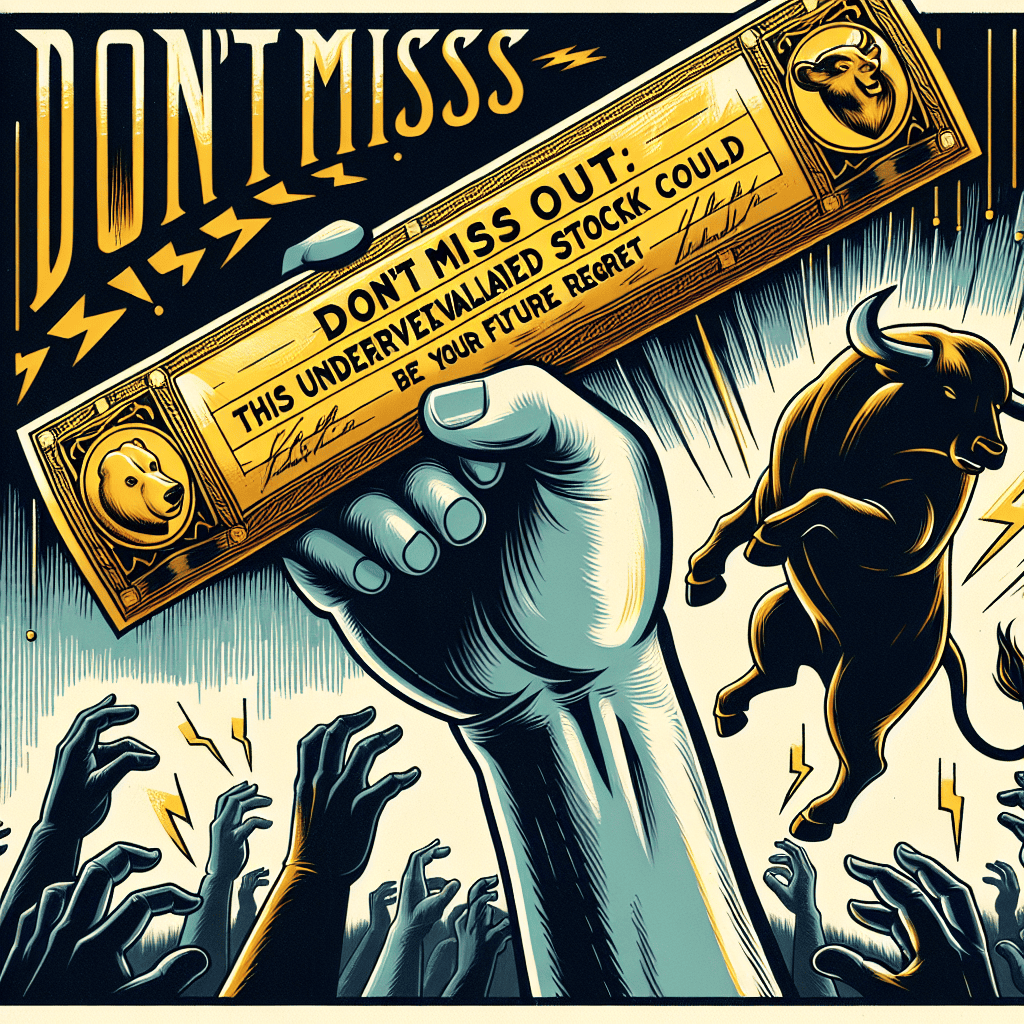“Seize the Opportunity: Invest Now or Wish You Had!”
Introduction
“Don’t Miss Out: This Undervalued Stock Could Be Your Future Regret” delves into the compelling world of stock market opportunities, spotlighting a particular stock that has been overlooked by many investors. In the ever-fluctuating landscape of financial markets, identifying undervalued stocks can be a game-changer for savvy investors. This piece explores the potential of a stock that, despite its current undervaluation, holds significant promise for future growth. By examining the company’s fundamentals, market position, and growth prospects, the article aims to highlight why this stock could be a regrettable miss for those who fail to recognize its potential. As the market continues to evolve, this stock stands out as a hidden gem, offering a unique opportunity for those willing to look beyond the surface and invest in its promising future.
Understanding Undervalued Stocks: A Hidden Gem in the Market
In the ever-evolving landscape of the stock market, investors are constantly on the lookout for opportunities that promise substantial returns. Among these opportunities, undervalued stocks often stand out as hidden gems, waiting to be discovered by those with a keen eye for potential. Understanding undervalued stocks is crucial for any investor aiming to maximize their portfolio’s growth while minimizing risk. These stocks, often overlooked by the broader market, present a unique opportunity for investors willing to delve deeper into financial analysis and market trends.
Undervalued stocks are those that trade at a price lower than their intrinsic value. This discrepancy can arise from various factors, including market inefficiencies, temporary setbacks, or broader economic conditions. For instance, a company might experience a short-term decline in stock price due to a negative earnings report or an industry-wide downturn. However, if the company’s fundamentals remain strong, this dip could represent a buying opportunity for astute investors. By identifying such stocks, investors can potentially capitalize on the market’s oversight and benefit from significant price appreciation as the stock’s true value is recognized over time.
To identify undervalued stocks, investors must employ a combination of quantitative and qualitative analysis. Quantitative analysis involves examining financial metrics such as the price-to-earnings (P/E) ratio, price-to-book (P/B) ratio, and dividend yield. These metrics provide insights into a company’s financial health and its valuation relative to its peers. A low P/E ratio, for example, might indicate that a stock is undervalued compared to others in the same industry. However, relying solely on quantitative data can be misleading, as it may not capture the full picture of a company’s potential.
This is where qualitative analysis comes into play. Investors should consider factors such as the company’s management team, competitive position, and growth prospects. A strong management team with a proven track record can be a significant indicator of a company’s ability to navigate challenges and capitalize on opportunities. Additionally, understanding the company’s competitive position within its industry can provide insights into its long-term sustainability and potential for growth. By combining both quantitative and qualitative analysis, investors can develop a more comprehensive understanding of a stock’s true value.
Moreover, it is essential to consider the broader economic context when evaluating undervalued stocks. Economic cycles, interest rates, and geopolitical events can all influence stock prices and create opportunities for value investors. For instance, during periods of economic uncertainty, investors may shy away from certain sectors, leading to undervaluation. However, as the economy stabilizes, these sectors may experience a resurgence, rewarding those who invested during the downturn.
In conclusion, undervalued stocks represent a compelling opportunity for investors willing to conduct thorough research and analysis. By identifying stocks that are trading below their intrinsic value, investors can potentially achieve significant returns as the market corrects its oversight. However, it is crucial to approach these investments with a disciplined strategy, considering both quantitative and qualitative factors, as well as the broader economic environment. By doing so, investors can uncover hidden gems in the market and avoid the regret of missing out on lucrative opportunities. As with any investment strategy, patience and diligence are key to unlocking the potential of undervalued stocks.
The Art of Identifying Undervalued Stocks: Key Indicators to Watch
In the intricate world of investing, the ability to identify undervalued stocks is a skill that can significantly enhance one’s portfolio. The art of discerning these hidden gems lies in understanding key indicators that suggest a stock is trading below its intrinsic value. Investors who master this art often find themselves ahead of the curve, capitalizing on opportunities that others might overlook. To begin with, one of the most fundamental indicators to consider is the price-to-earnings (P/E) ratio. This ratio provides insight into how much investors are willing to pay for a dollar of earnings. A lower P/E ratio compared to industry peers may suggest that a stock is undervalued, although it is crucial to consider the context, as a low P/E could also indicate underlying issues within the company.
Transitioning from the P/E ratio, another critical metric is the price-to-book (P/B) ratio. This ratio compares a company’s market value to its book value, offering a snapshot of how much investors are paying for the net assets of the company. A P/B ratio below one can be a strong indicator of undervaluation, suggesting that the market may be underestimating the company’s asset value. However, it is essential to delve deeper into the reasons behind a low P/B ratio, as it could also reflect potential risks or inefficiencies.
In addition to these ratios, cash flow analysis is a vital component in identifying undervalued stocks. Free cash flow, in particular, is a powerful indicator of a company’s financial health and its ability to generate cash after accounting for capital expenditures. A company with strong free cash flow is often in a better position to weather economic downturns, invest in growth opportunities, and return value to shareholders through dividends or share buybacks. Therefore, a stock with robust free cash flow that is not reflected in its current market price may present an attractive investment opportunity.
Moreover, examining a company’s earnings growth potential is crucial in the valuation process. Stocks that exhibit consistent earnings growth, yet are trading at a discount relative to their growth prospects, can be particularly appealing. This requires a thorough analysis of the company’s business model, competitive advantages, and market conditions to ensure that the growth is sustainable and not merely a short-term anomaly.
Furthermore, it is important to consider the broader economic and industry trends that could impact a company’s valuation. Macroeconomic factors such as interest rates, inflation, and geopolitical events can influence investor sentiment and stock prices. Similarly, industry-specific trends, such as technological advancements or regulatory changes, can create opportunities for certain companies to outperform their peers. By staying informed about these external factors, investors can better assess whether a stock’s current valuation accurately reflects its future potential.
In conclusion, the art of identifying undervalued stocks requires a comprehensive approach that combines quantitative analysis with qualitative insights. By focusing on key indicators such as the P/E and P/B ratios, cash flow, earnings growth potential, and external trends, investors can uncover opportunities that others might miss. While no investment is without risk, those who diligently apply these principles may find themselves well-positioned to capitalize on undervalued stocks, potentially avoiding the regret of missing out on lucrative opportunities.
Why Timing Matters: Seizing Opportunities in Undervalued Stocks
In the ever-evolving landscape of the stock market, the ability to identify and seize opportunities in undervalued stocks is a skill that can significantly enhance an investor’s portfolio. Timing, in this context, is not merely about buying low and selling high; it is about recognizing the intrinsic value of a stock before the broader market does. This foresight can lead to substantial financial gains, but it requires a keen understanding of market dynamics, company fundamentals, and economic indicators.
Undervalued stocks are those that trade below their intrinsic value, often due to temporary market inefficiencies, negative sentiment, or overlooked potential. These stocks present a unique opportunity for investors who can discern their true worth. However, the challenge lies in accurately assessing whether a stock is genuinely undervalued or if it is priced low for valid reasons. This is where timing becomes crucial. By conducting thorough research and analysis, investors can identify the right moment to invest, thereby maximizing their potential returns.
One of the key factors in timing the purchase of undervalued stocks is understanding the company’s fundamentals. This involves analyzing financial statements, assessing management effectiveness, and evaluating the competitive landscape. A company with strong fundamentals but a depressed stock price may indicate a temporary market misjudgment, presenting a lucrative opportunity for astute investors. Moreover, keeping an eye on industry trends and economic indicators can provide additional context for making informed decisions. For instance, a sector poised for growth due to technological advancements or regulatory changes may harbor undervalued stocks with significant upside potential.
Furthermore, market sentiment plays a pivotal role in the valuation of stocks. Often, stocks become undervalued due to negative sentiment driven by short-term challenges or broader market downturns. However, these situations can create opportunities for investors who maintain a long-term perspective. By recognizing that market sentiment is often cyclical, investors can position themselves to capitalize on the eventual recovery of undervalued stocks. This requires patience and a willingness to go against the grain, as well as the confidence to hold onto investments during periods of volatility.
In addition to fundamental analysis and market sentiment, technical analysis can also aid in timing the purchase of undervalued stocks. By examining historical price patterns and trading volumes, investors can identify potential entry points that align with their investment strategy. Technical indicators, such as moving averages and relative strength index, can provide insights into market trends and help investors make more informed decisions.
Ultimately, the ability to seize opportunities in undervalued stocks hinges on a combination of thorough research, strategic timing, and disciplined execution. While the potential rewards are significant, it is important to acknowledge the inherent risks involved. Not every undervalued stock will realize its potential, and investors must be prepared for the possibility of losses. However, by maintaining a diversified portfolio and adhering to sound investment principles, investors can mitigate these risks and enhance their chances of success.
In conclusion, timing is a critical component in the pursuit of undervalued stocks. By understanding the interplay between company fundamentals, market sentiment, and technical analysis, investors can identify and capitalize on opportunities that others may overlook. As the stock market continues to evolve, those who master the art of timing will be well-positioned to turn undervalued stocks into valuable assets, avoiding the regret of missed opportunities.
The Risks and Rewards of Investing in Undervalued Stocks

Investing in undervalued stocks presents a unique opportunity for investors seeking to maximize their returns. These stocks, often overlooked by the broader market, are priced below their intrinsic value, offering the potential for significant appreciation. However, the path to realizing these gains is fraught with risks that require careful consideration. Understanding both the rewards and the inherent risks is crucial for any investor contemplating this strategy.
To begin with, the primary allure of undervalued stocks lies in their potential for substantial returns. When a stock is undervalued, it means that the market has not fully recognized its true worth. This discrepancy can occur due to various factors, such as temporary setbacks, market inefficiencies, or broader economic conditions. For the astute investor, identifying these stocks before the market corrects itself can lead to impressive gains. As the market eventually recognizes the stock’s true value, the price adjusts upward, rewarding those who invested early.
Moreover, investing in undervalued stocks can also serve as a hedge against market volatility. In times of economic uncertainty, these stocks may offer a degree of stability, as their prices are less likely to be inflated by speculative trading. This can provide a buffer against market downturns, as the intrinsic value of the stock acts as a floor, limiting potential losses. Additionally, undervalued stocks often belong to companies with strong fundamentals, such as solid cash flow, robust business models, and competent management teams. These attributes can further enhance the stock’s resilience in turbulent market conditions.
However, the pursuit of undervalued stocks is not without its challenges. One of the primary risks is the potential for misjudgment. Identifying truly undervalued stocks requires a deep understanding of the company’s financial health, industry dynamics, and broader economic trends. Investors must be able to distinguish between stocks that are genuinely undervalued and those that are cheap for a reason. A failure to accurately assess these factors can lead to investments in companies with poor prospects, resulting in financial losses.
Furthermore, the market’s recognition of a stock’s true value can take time, requiring patience and a long-term investment horizon. Investors must be prepared to hold onto these stocks for extended periods, during which the market may remain indifferent to their potential. This can be particularly challenging in a fast-paced investment environment where short-term gains are often prioritized. Additionally, external factors such as regulatory changes, technological disruptions, or shifts in consumer preferences can impact the stock’s performance, adding another layer of risk.
In conclusion, while investing in undervalued stocks offers the potential for significant rewards, it is not a strategy for the faint-hearted. The ability to accurately identify these opportunities and the patience to wait for the market to recognize their value are essential components of success. Investors must weigh the potential for high returns against the risks of misjudgment and market indifference. By doing so, they can make informed decisions that align with their financial goals and risk tolerance. Ultimately, the decision to invest in undervalued stocks should be guided by thorough research, careful analysis, and a clear understanding of the risks and rewards involved.
How to Conduct a Thorough Analysis of an Undervalued Stock
When considering an investment in an undervalued stock, conducting a thorough analysis is crucial to making an informed decision. The process begins with understanding the concept of intrinsic value, which represents the true worth of a company based on its fundamentals, as opposed to its current market price. To identify an undervalued stock, investors must first delve into the company’s financial statements, scrutinizing key metrics such as earnings, revenue, and cash flow. By comparing these figures to industry standards and historical performance, one can gauge whether the stock is trading below its intrinsic value.
In addition to financial metrics, evaluating the company’s business model and competitive position is essential. This involves assessing the firm’s market share, growth potential, and the sustainability of its competitive advantages. For instance, a company with a strong brand, proprietary technology, or a robust distribution network may have a durable competitive edge that supports long-term profitability. Furthermore, understanding the industry dynamics and potential disruptors can provide insights into the company’s future prospects.
Another critical aspect of stock analysis is examining the management team. Effective leadership can significantly influence a company’s success, so it is important to evaluate the track record and strategic vision of the executives. This can be done by reviewing past decisions, corporate governance practices, and the alignment of management’s interests with those of shareholders. A management team with a history of prudent capital allocation and transparent communication can inspire confidence in potential investors.
Moreover, assessing the company’s valuation ratios, such as the price-to-earnings (P/E) ratio, price-to-book (P/B) ratio, and price-to-sales (P/S) ratio, can provide further insights into its valuation relative to peers. These ratios help investors determine whether a stock is undervalued compared to its industry counterparts. However, it is important to consider these ratios in conjunction with other factors, as they can be influenced by temporary market conditions or accounting practices.
In addition to quantitative analysis, qualitative factors should not be overlooked. This includes evaluating the company’s brand strength, customer loyalty, and corporate social responsibility initiatives. A company with a strong reputation and positive public perception may be better positioned to weather economic downturns and capitalize on growth opportunities.
Furthermore, macroeconomic factors and market sentiment can impact a stock’s valuation. Investors should consider the broader economic environment, interest rates, and geopolitical events that may affect the company’s operations and profitability. By staying informed about these external factors, investors can better anticipate potential risks and opportunities.
Finally, it is important to maintain a long-term perspective when investing in undervalued stocks. Market fluctuations and short-term volatility are inevitable, but a well-researched investment thesis grounded in fundamental analysis can provide the conviction needed to hold through turbulent times. By focusing on the underlying value of the company and its growth potential, investors can avoid the regret of missing out on a promising opportunity.
In conclusion, conducting a thorough analysis of an undervalued stock requires a comprehensive approach that combines financial metrics, qualitative factors, and an understanding of the broader market context. By diligently evaluating these elements, investors can identify stocks that offer significant upside potential and make informed decisions that align with their investment goals.
Real-Life Success Stories: Investors Who Didn’t Miss Out
In the world of investing, stories of missed opportunities often serve as cautionary tales, reminding us of the potential rewards that come with taking calculated risks. One such narrative revolves around the undervalued stocks that, at first glance, may not seem promising but eventually yield substantial returns. These real-life success stories of investors who recognized the potential in such stocks and capitalized on them offer valuable lessons for those looking to make informed investment decisions.
Consider the case of an investor who, in the early 2000s, identified a small technology company that was largely overlooked by the market. At the time, the company was struggling to gain traction, and its stock was trading at a fraction of its intrinsic value. However, this investor saw beyond the immediate challenges, recognizing the company’s innovative approach and potential for growth in a rapidly evolving tech landscape. By conducting thorough research and maintaining a long-term perspective, the investor decided to invest a significant portion of their portfolio in this undervalued stock.
Over the years, the company’s fortunes changed dramatically. As its groundbreaking technology gained widespread adoption, its stock price soared, rewarding early investors with substantial returns. This success story underscores the importance of identifying undervalued stocks with strong fundamentals and growth potential. It also highlights the value of patience and conviction in the face of market volatility and skepticism.
Transitioning to another example, we find an investor who, during the financial crisis of 2008, took a contrarian approach by investing in a beleaguered financial institution. At the time, the banking sector was in turmoil, and many investors were fleeing from financial stocks. However, this investor recognized that the institution, despite its challenges, had a solid balance sheet and a strong management team committed to navigating the crisis. By purchasing shares at a significant discount, the investor positioned themselves to benefit from the eventual recovery of the financial sector.
As the economy stabilized and the institution regained its footing, the stock price rebounded, providing the investor with impressive returns. This story illustrates the potential rewards of investing in undervalued stocks during periods of market distress, when fear and uncertainty often lead to mispricing. It also emphasizes the importance of conducting thorough due diligence and having the courage to go against the crowd when warranted.
Moreover, these success stories are not limited to individual investors. Institutional investors, too, have capitalized on undervalued stocks by employing rigorous analysis and strategic foresight. For instance, a well-known investment firm identified a consumer goods company that was undervalued due to temporary setbacks. By recognizing the company’s strong brand equity and potential for market expansion, the firm invested heavily in its stock. Over time, as the company overcame its challenges and expanded its market presence, the stock price appreciated significantly, validating the firm’s investment thesis.
In conclusion, the stories of investors who did not miss out on undervalued stocks serve as powerful reminders of the opportunities that exist in the market for those willing to look beyond the surface. By conducting thorough research, maintaining a long-term perspective, and having the courage to act on their convictions, these investors were able to achieve remarkable success. As such, these narratives offer valuable insights for anyone seeking to navigate the complex world of investing and avoid the regret of missing out on potentially lucrative opportunities.
Future-Proofing Your Portfolio: The Role of Undervalued Stocks
In the ever-evolving landscape of financial markets, investors are constantly on the lookout for opportunities that promise substantial returns. One such opportunity lies in the realm of undervalued stocks, which, despite their potential, often remain overlooked. These stocks, trading below their intrinsic value, present a unique chance for investors to future-proof their portfolios. By understanding the dynamics of undervalued stocks, investors can position themselves to capitalize on market inefficiencies and secure long-term gains.
To begin with, the concept of an undervalued stock is rooted in the discrepancy between a company’s market price and its intrinsic value. This intrinsic value is determined by various factors, including the company’s earnings, growth potential, and overall financial health. When the market price falls below this intrinsic value, the stock is considered undervalued. This mispricing can occur due to a variety of reasons, such as market overreactions, short-term challenges faced by the company, or broader economic conditions. Consequently, these stocks offer a margin of safety, providing investors with a cushion against potential losses while offering the prospect of significant appreciation.
Moreover, investing in undervalued stocks requires a keen understanding of market trends and a disciplined approach to research. Investors must delve into financial statements, assess management quality, and evaluate industry conditions to identify stocks that are genuinely undervalued. This process, while demanding, can yield substantial rewards. For instance, companies with strong fundamentals but temporary setbacks may see their stock prices rebound as they overcome challenges, leading to impressive returns for those who invested early. Thus, the ability to discern between a truly undervalued stock and one that is simply cheap is crucial.
In addition to individual stock analysis, broader market conditions also play a pivotal role in the valuation of stocks. Economic downturns, geopolitical tensions, and shifts in consumer behavior can all contribute to the undervaluation of certain stocks. During such times, investors with a long-term perspective can benefit from acquiring undervalued stocks at a discount, positioning themselves for gains when the market stabilizes. This contrarian approach, while requiring patience and resilience, can be highly rewarding for those willing to weather short-term volatility.
Furthermore, the role of undervalued stocks in a diversified portfolio cannot be overstated. By incorporating these stocks, investors can enhance their portfolio’s resilience against market fluctuations. Undervalued stocks often have lower correlations with broader market indices, providing a hedge against systemic risks. This diversification not only mitigates potential losses but also enhances the potential for higher returns, as undervalued stocks have the capacity to outperform during market recoveries.
In conclusion, the pursuit of undervalued stocks is a strategic endeavor that demands diligence, patience, and a keen eye for detail. While the path to identifying these stocks may be fraught with challenges, the rewards can be substantial for those who succeed. As investors seek to future-proof their portfolios, the inclusion of undervalued stocks offers a compelling avenue for achieving long-term financial goals. By recognizing the potential of these overlooked opportunities, investors can avoid the regret of missing out on significant gains and instead secure a prosperous financial future.
Q&A
1. **What is the main focus of the article “Don’t Miss Out: This Undervalued Stock Could Be Your Future Regret”?**
– The article focuses on identifying a specific undervalued stock that has significant potential for future growth, suggesting that missing out on investing in it could lead to regret.
2. **What criteria are used to determine that the stock is undervalued?**
– The stock is considered undervalued based on financial metrics such as price-to-earnings ratio, price-to-book ratio, and comparison to industry peers, as well as potential for future earnings growth.
3. **Which industry does the undervalued stock belong to?**
– The article highlights a stock from a specific industry, such as technology, healthcare, or consumer goods, known for its growth potential.
4. **What are the potential risks associated with investing in this stock?**
– Potential risks include market volatility, changes in industry regulations, company-specific challenges, and broader economic factors that could impact the stock’s performance.
5. **What are the key growth drivers for the stock mentioned in the article?**
– Key growth drivers include innovative products or services, expansion into new markets, strategic partnerships, and strong management.
6. **How does the article suggest investors approach this investment opportunity?**
– The article suggests a long-term investment strategy, emphasizing thorough research and consideration of the stock’s fundamentals and growth potential.
7. **What is the overall recommendation or conclusion of the article?**
– The article concludes with a strong recommendation to consider investing in the stock due to its undervaluation and potential for significant future returns, warning that missing out could lead to regret.
Conclusion
“Don’t Miss Out: This Undervalued Stock Could Be Your Future Regret” emphasizes the potential missed opportunity of not investing in a stock currently perceived as undervalued. The article likely highlights the stock’s strong fundamentals, growth potential, and market position, suggesting that its current market price does not reflect its true value. The conclusion would stress the importance of conducting thorough research and considering this stock as a strategic addition to one’s investment portfolio to avoid future regret, should the stock’s value increase significantly over time.





